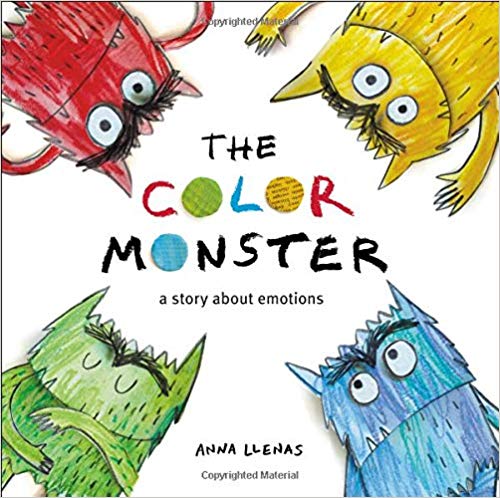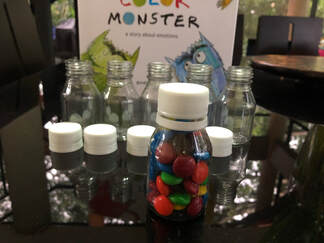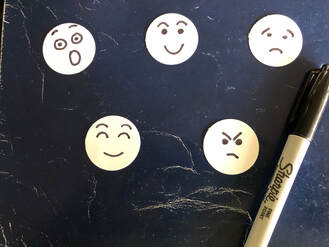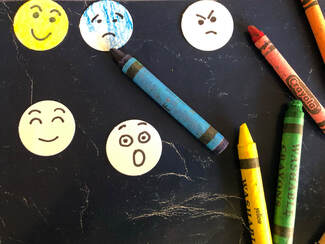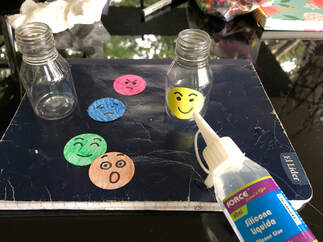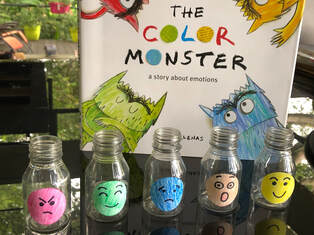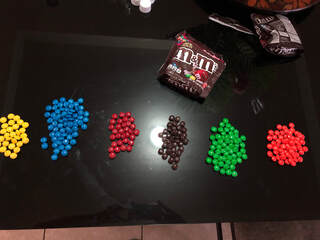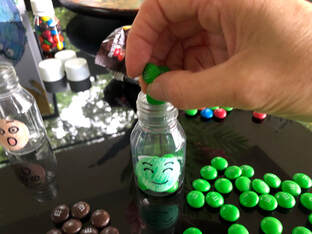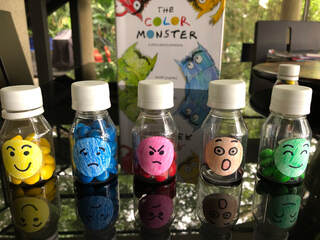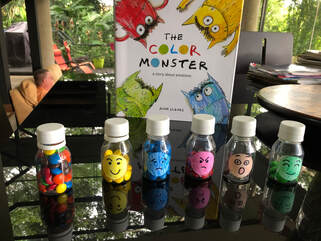A Book Review of The Color Monster, |
| The Color Monster a story about emotions Written & Illustrated by Anna Llenas Publisher: Little Brown and Company Emotional self-regulation is the ability to modulate your feelings and reactions when confronted with physical or emotional stressors in your environment. It is the ability to calm yourself when faced with big emotions. The key to emotional regulation, social-emotional health and empathy is recognizing emotions in yourself and others. |
Learning words for feelings, how they feel in your body, and how they look on others is crucial to social-emotional development. This skill is not something that children learn quickly, but a concept that requires frequent repetition and practice. The reason for tantruming in toddlers and young children is the fact that they have not yet learned to regulate their own emotions. Many adults continue to struggle with identifying and modulating their emotions. The lack of this skill can cause problems with relationships as well as behavioral problems throughout life. It is important to start the learning process about feelings as early as possible.
Talking about, modeling and reading about feelings with children from a young age can give them a head start in mastering emotional regulation. There are a number of children's books about feelings out in the world, but one of my favorites is The Color Monster, the story of emotions by Anna Llenas.
The Color Monster is a simple, powerful book. Through the experience of an irresistibly adorable monster and his young helper, kids can eagerly learn about their emotions. Ms. Llenas explains feelings in a clear, supportive, child-friendly manner. The collage-like illustrations and vivid colors bring the words to life.
The crayon-colored monster starts out confused, with his emotions all mixed together. His young friend helps him sort out his emotions so he can make sense of how he feels. The book explores the main emotions including happy, sad, angry, scared and calm. Ms. Llenas describes clearly how each emotion feels. The illustrations pull you into the story and help you to feel the emotion, along with the monster. The exaggeration of monster's facial expressions and the vivid colors makes this book especially friendly to very young children. The Color Monster is appropriate for kids ages 2.5 - 8.
There are tender, supportive statements woven into the story to support young children when learning about difficult emotions. The story ends on a sweet, loving note. The take-away from the story is if you sort out those big feelings and try to understand where they are coming from, you can help yourself feel better. This is a good message and reminder for all of us!
Below is an activity to help your own kids, clients or students sort out their feelings.
Talking about, modeling and reading about feelings with children from a young age can give them a head start in mastering emotional regulation. There are a number of children's books about feelings out in the world, but one of my favorites is The Color Monster, the story of emotions by Anna Llenas.
The Color Monster is a simple, powerful book. Through the experience of an irresistibly adorable monster and his young helper, kids can eagerly learn about their emotions. Ms. Llenas explains feelings in a clear, supportive, child-friendly manner. The collage-like illustrations and vivid colors bring the words to life.
The crayon-colored monster starts out confused, with his emotions all mixed together. His young friend helps him sort out his emotions so he can make sense of how he feels. The book explores the main emotions including happy, sad, angry, scared and calm. Ms. Llenas describes clearly how each emotion feels. The illustrations pull you into the story and help you to feel the emotion, along with the monster. The exaggeration of monster's facial expressions and the vivid colors makes this book especially friendly to very young children. The Color Monster is appropriate for kids ages 2.5 - 8.
There are tender, supportive statements woven into the story to support young children when learning about difficult emotions. The story ends on a sweet, loving note. The take-away from the story is if you sort out those big feelings and try to understand where they are coming from, you can help yourself feel better. This is a good message and reminder for all of us!
Below is an activity to help your own kids, clients or students sort out their feelings.
Activity Ideas for The Color Monster
Materials Needed:
7 small clear plastic containers
Large bag of M & M candies or anything small that can be sorted by color
Hand drawn face circles, printed face emojis or colored round labels
Sharpie black marker
Crayons
Scissors
Glue (silocone glue works better on plastic)
7 small clear plastic containers
Large bag of M & M candies or anything small that can be sorted by color
Hand drawn face circles, printed face emojis or colored round labels
Sharpie black marker
Crayons
Scissors
Glue (silocone glue works better on plastic)
| Directions: 1. Have child fill one jar with M & M's with all the colors jumbled up. (Let child eat some M & M's during activity because, why not?!) 2. Explain to child that this is what's happening inside of them when they have so many big feelings and they're about to explode. 3. Explain that it helps to sort out these feelings, like the monster, so they can understand what is going on inside. This will help them learn to calm down when overwhelmed with feelings. 4. Trace circles with bottle tops and cut them out. Draw feeling faces on circles with sharpie marker. Adult can draw for younger children, older children can draw themselves (or use computer printed emojis or draw faces on round colored labels). Name the feelings in the book and draw a face for each one - happy, sad, angry, scared, calm. 5. Have child color faces with crayons. Child can use feeling colors from the book or decide on their own colors for each feeling. Sticking with the M & M colors, I used: yellow-happy blue-sad red-angry brown-scared (black/grey in book) green-calm There are also Orange M & M's. Child can pick another emotion to use for orange, ie. worried, anxious, loving, disappointed, frustrated, etc. Help the child think of one that they experience often. 6. Have child glue faces on containers. 7. Dump out M & M's on table and have child sort by color. 8. Have child decide how big each of their feelings are by choosing the number of M & M's to put in its corresponding feeling container. The more M & M's, the bigger the feeling. Explain that this can change quickly and often but that you want to know how they are feeling now. You can also do this part by saying, how big would the feelings be if you were thinking about...i.e. when Spot died, when Jacob took your toy, etc. Make sure that they are not just filling up all the containers, that they are thinking about each of the feelings and choosing how big they are. 9. In this example, this child has more sad feelings than happy, a little anger, a little calm, and almost no fear. It would be important to discuss what those sad feelings are about. For example: "Wow, you have a lot of sad feelings, what is that about?" In fact, go through all of the feelings and discuss what makes them feel each one. 10. Completed project! Keep these handy and check in on the child's feelings often (you'll have to keep an extra bag of M & M's on hand for this! Darn!). This would be very useful after child calms down from a melt down (no pun intended!). Discuss what they were feeling and re-do the M & M amounts together. Have fun! |
4 Comments
Follow me on Twitter, Pinterest and LinkedIn
Categories
All
Absent Dad
Acceptance & Commitment -Therapy Skills
Acceptance Of Others
ADHD
Adoption
Anger Management
Anxiety
Body Autonomy
Cognitive Behavioral Therapy Skills
Consent
Coping With ADHD
Coping With Depression
Coping With Feelings
Depression
Disability Awareness
Disappointment
Divorce
Domestic Violence
Empathy
Fear
Feelings General
Feelings-General
Foster Care
Gender Identity
Giftedness
Grandparents As Guardians
Grief & Loss
Growth Mindset
Incarcerated Parent
Kindness
Kinship Care
Learning Disabilities
Making Friends
Mindfulness
Negative Self Talk
Parental Anger
Parental Arguing
Parent W/Mental Illness
Parent W/Substance Abuse
Racial Injustice
School Lockdown Drills
Seizures
Self Esteem
Sensory Issues
Separation Anxiety
Sexual Abuse
Sexual Abuse Prevention
Shyness
Standing Up For Others
Suicide
Supporting A Friend
Temper Tantrums
Terminal Illness
Trauma
White Privilege
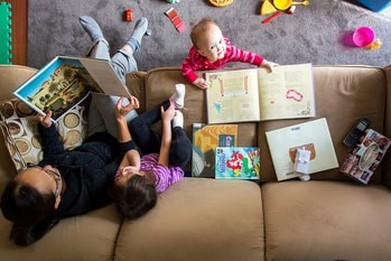
 RSS Feed
RSS Feed
